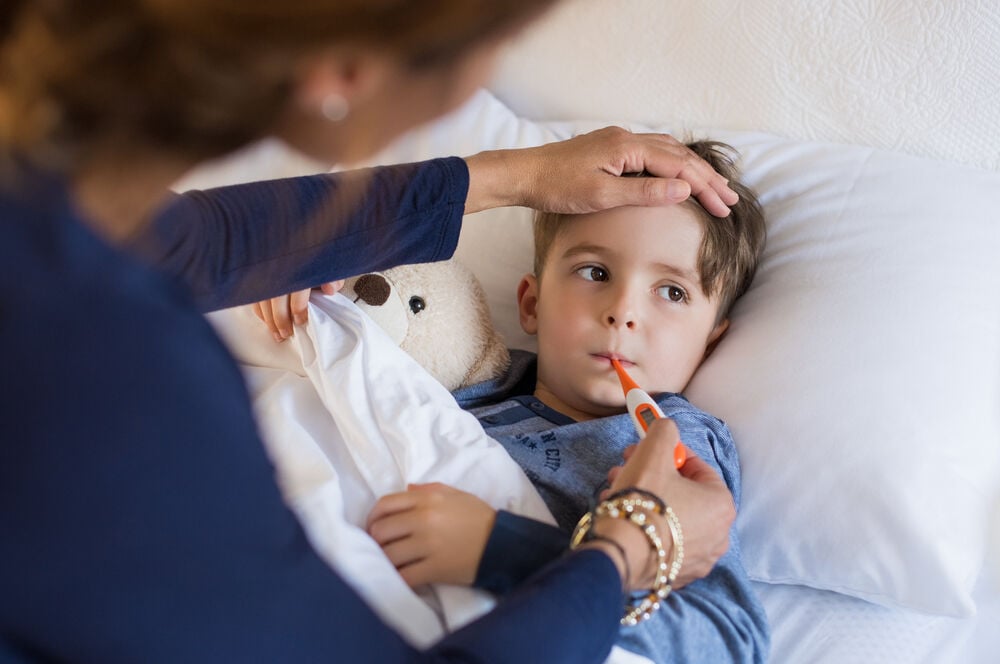Influenza is a viral respiratory infection that anyone can catch, regardless of age. Since it’s easily spread from one individual to the next, recognizing the warning signs is crucial. Learn more about what steps to take when you notice flu symptoms in children.
-
Tracking cycle
-
Getting pregnant
-
Pregnancy
-
Help Center
-
Flo for Partners
-
Anonymous Mode
-
Flo app reviews
-
Flo Premium New
-
Secret Chats New
-
Symptom Checker New
-
Your cycle
-
Health 360°
-
Getting pregnant
-
Pregnancy
-
Being a mom
-
LGBTQ+
-
Quizzes
-
Ovulation calculator
-
hCG calculator
-
Pregnancy test calculator
-
Menstrual cycle calculator
-
Period calculator
-
Implantation calculator
-
Pregnancy weeks to months calculator
-
Pregnancy due date calculator
-
IVF and FET due date calculator
-
Due date calculator by ultrasound
-
Medical Affairs
-
Science & Research
-
Pass It On Project New
-
Privacy Portal
-
Press Center
-
Flo Accuracy
-
Careers
-
Contact Us
Flu Symptoms in Kids: How to Recognize Them and What to Do


Every piece of content at Flo Health adheres to the highest editorial standards for language, style, and medical accuracy. To learn what we do to deliver the best health and lifestyle insights to you, check out our content review principles.
An overview of the flu in children
Triggered by the constantly changing influenza virus, the flu may strike the same person twice within a fairly short period. A developed immunity to one strain won’t necessarily protect you from another strain.
Occasionally, the virus very quickly alters itself, leading to an influenza pandemic strong enough to affect thousands, or even millions, of people around the globe.
It’s readily transmitted, especially in crowded spaces through sneezing or coughing. The virus is also capable of surviving on surfaces or objects for a certain amount of time. Unfortunately, children are among the groups most susceptible to catching and sharing it.
Most common flu symptoms in kids

Take a quiz
Find out what you can do with our Health Assistant
Influenza creates more severe symptoms than the common cold, and may keep your little one from engaging in their daily routine. Early symptoms of influenza in kids include:
- Fever
- Chills
- Headaches
- Muscle aches
- Nasal congestion
- Fatigue
- Sore throat
- Loss of appetite
- Dry cough that progressively worsens
These are the major differences between common cold and flu symptoms:
- A cold usually results in low fever or no fever at all.
- Sneezing, sore throat, and stuffy nose don’t necessarily accompany the flu.
- Coughing tends to be more severe with the flu than the common cold.
- The flu is marked by intense body aches and extreme fatigue.
While most flu patients experience similar symptoms regardless of age, there could be a few exceptions.
- Your newborn or infant might develop a high fever without other signs of the flu.
- High fever (above 103.1 degrees Fahrenheit or 39.5 degrees Celsius) is also a common flu symptom in toddlers and babies, at times accompanied by febrile seizures.
- Digestive issues like vomiting, diarrhea, upset stomach, and abdominal pain are more often observed in children than adults.
- It could increase your baby’s chances of getting other types of infections, such as pneumonia, bronchiolitis, or croup.
Generally speaking, your little one should recover from the flu in approximately one week, but may still feel fatigued for up to four weeks. In severe cases, influenza has been known to cause serious, even fatal, complications.
What causes the flu in children?
Of the three types of influenza viruses (A, B, and C), it’s the first two that are responsible for the annual outbreak which usually occurs between November and April. Researchers focus on trying to prevent the spread of these two constantly mutating flu strains. Influenza type C, however, only produces mild respiratory symptoms, if any at all.
Common ways to treat the flu in children
Treatment of your child’s influenza varies greatly depending on their age, symptoms, overall health, and severity of illness. Many options aim to relieve symptoms or simply stop them from worsening. Medications typically used for influenza in children include:
- Acetaminophen: It alleviates muscle aches and lowers fever. Aspirin should never be given to a baby with the flu as it might create severe complications.
- Antiviral drugs: These attempt to shorten the duration of the disease, when possible.
- Cough medicine
Always remember to consult your pediatrician before providing your child with any flu medications. Also note that antibiotics are not effective at battling the flu, and should only be used in the event of a bacterial complication.
During a bout of influenza, consider taking the following measures:
- Ensure your baby gets plenty of bed rest and remains comfortable.
- Supply a lot of fluids to keep them hydrated.
- Monitor their temperature regularly. If they have a fever, ask your doctor about the right dosage of acetaminophen.
- Offer them small, nutritious meals, even when they don’t want to eat.
- Avoid putting on excessive clothing if they have a fever, and keep the room temperature at roughly 70 degrees Fahrenheit or 20 degrees Celsius.
- Use a cool-mist humidifier or rubber suction bulb to help relieve your little one’s nasal congestion.
- Warm water gargles are beneficial for a sore throat, and lozenges may be offered to children over the age of 3.
- Seek medical attention immediately if your baby has an underlying condition, such as asthma, an immune system disorder, or heart disease.
- Lastly, remember that decongestants and antihistamines are ineffective at relieving flu symptoms, and nasal sprays shouldn’t be used in children under the age of 6.
Flu complications to be aware of
More often than not, your child will bounce right back after getting the flu. However, complications do occasionally occur and might include:
- Sinus and ear infections
- Pneumonia
- Myocarditis (inflammation of the heart)
- Encephalitis (inflammation of the brain)
- Myositis (inflammation of the muscles)
- Rhabdomyolysis (degeneration of muscle tissue)
- Organ failure
- Sepsis (the body’s generalized response to an infection)
- Increased asthma attacks
- Worsening of existing chronic conditions
Tips to prevent the flu in children
Two specific types of influenza vaccines are recommended for use in children:
- Flu shot: Safe for babies over the age of 6 months, it contains dead, inactive viruses and will not actually cause the flu.
- Nasal spray swine flu vaccine: It uses a live, weakened virus and is approved for children 2 years old and up. However, it’s contraindicated for kids with asthma or other chronic respiratory illnesses.
Since infants under 6 months cannot be vaccinated for influenza, experts recommend that mothers get a flu shot during pregnancy. This will provide them with antibodies at birth. Once they reach the proper age, check with your pediatrician to ensure you’re following their vaccine schedule accordingly.
Takeaway
Influenza is a viral respiratory infection that your baby should be able to fight off in approximately one week. It’s important to learn how to recognize flu symptoms in kids, particularly if they become severe, so you can seek medical assistance right away.
Once they reach 6 months of age, consider protecting your little one from the flu with routine vaccinations.


Hey, I'm Anique
I started using Flo app to track my period and ovulation because we wanted to have a baby.


The Flo app helped me learn about my body and spot ovulation signs during our conception journey.


I vividly
remember the day
that we switched
Flo into
Pregnancy Mode — it was
such a special
moment.
Real stories, real results
Learn how the Flo app became an amazing cheerleader for us on our conception journey.




